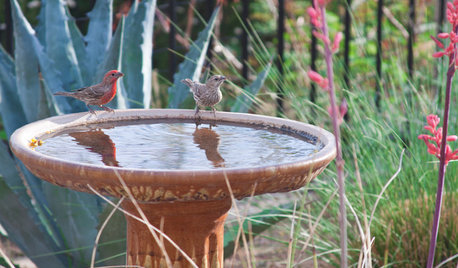Bird ID
farmboy1
11 years ago
Related Stories

GARDENING GUIDESBackyard Birds: Northern Cardinals in the Snow, and Other Red Birds
Brilliant crimson feathers make these friends stand out in a crowd
Full Story
GARDENING FOR BUTTERFLIESA Quick-Start Guide to Bird-Watching for Fun and Learning
Set out some seed and grab your field guide. Bird-watching is an easy, entertaining and educational activity for the whole family
Full Story
GARDENING FOR BUTTERFLIESBring on the Birds: Natural Habitat Ideas for Gardens of All Sizes
Provide nesting, watering and perching spots inspired by the Costa Rican jungle and watch the birds flock on over
Full Story
Are Butterflies the New Birds?
Let these pretty winged creatures be the new totem of hip décor
Full Story
GARDENING GUIDESBackyard Birds: Create a Home for American Kestrels
These copper-colored birds of prey can be found throughout North and South America and often find habitats near human activity
Full Story
GARDENING FOR BIRDSWild Birds Transform a Woman’s Garden and Life
How Sharon Sorenson created a wildlife haven and became the Bird Lady of Southern Indiana
Full Story
GARDENING GUIDESMake Your Garden a Haven for Backyard Birds
Create a bird-friendly habitat in your yard with food, water and shelter
Full Story
GARDENING GUIDESBackyard Birds: The Wonder of Warblers
These small, dynamic birds call North America home, with the yellow-rumped warbler flocking to every U.S. state
Full Story
GARDENING GUIDESBackyard Birds: How to Care for American Goldfinches
The American goldfinch is a bright-in-the-summer visitor and one of the only vegetarian songbirds. Here's how to give them a healthy habitat
Full Story
GARDENING FOR BIRDSBackyard Birds: Those Nutty Nuthatches
The North American songbirds, which often perch upside down, make themselves known in the winter landscape
Full StorySponsored
Your Custom Bath Designers & Remodelers in Columbus I 10X Best Houzz





lazy_gardens
tmff
Related Discussions
Bird ID
Q
new bird id help
Q
Bird ID, please!
Q
Help with bird ID
Q
tmff
farmboy1Original Author
farmboy1Original Author
tmff
tmff
farmboy1Original Author
farmboy1Original Author
tmff
farmboy1Original Author
tmff
farmboy1Original Author
calliope
farmboy1Original Author
calliope